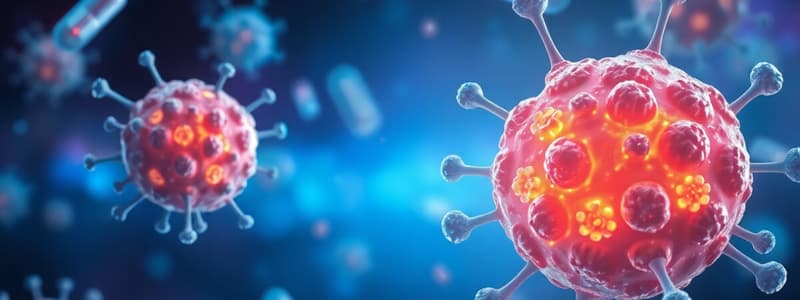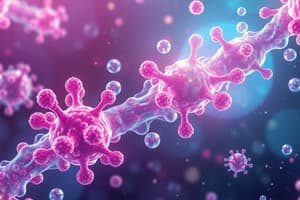Podcast
Questions and Answers
What is the objective of this lecture?
What is the objective of this lecture?
The objective of the lecture is to discuss the pharmacology of broad-spectrum antibiotics, Tetracyclines and Chloramphenicol and pharmacology of antifungal drugs.
Which of the following are considered broad-spectrum antibiotics?
Which of the following are considered broad-spectrum antibiotics?
- Tetracyclines (correct)
- Chloramphenicol (correct)
- Antifungal drugs
What is the mechanism of action of tetracyclines?
What is the mechanism of action of tetracyclines?
Tetracyclines inhibit protein synthesis by binding to the 30S ribosome in susceptible organisms, inhibiting the binding of aminoacyl tRNA to mRNA, ultimately preventing the growth of the peptide chain.
What is the primary source of tetracyclines?
What is the primary source of tetracyclines?
Tetracyclines are primarily bacteriocidal.
Tetracyclines are primarily bacteriocidal.
The indiscriminate use of tetracyclines has led to the development of resistant strains.
The indiscriminate use of tetracyclines has led to the development of resistant strains.
What is the primary route of administration for tetracyclines?
What is the primary route of administration for tetracyclines?
Tetracyclines are generally well absorbed in the presence of food.
Tetracyclines are generally well absorbed in the presence of food.
Which of the following is NOT a commonly reported adverse effect of tetracyclines?
Which of the following is NOT a commonly reported adverse effect of tetracyclines?
What precautions should be taken when administering tetracyclines?
What precautions should be taken when administering tetracyclines?
What is the mechanism of action of chloramphenicol?
What is the mechanism of action of chloramphenicol?
Chloramphenicol is particularly effective against Salmonella typhi.
Chloramphenicol is particularly effective against Salmonella typhi.
What is a major concern associated with the use of chloramphenicol?
What is a major concern associated with the use of chloramphenicol?
What are some of the common uses of chloramphenicol?
What are some of the common uses of chloramphenicol?
What are some examples of fungal infections that are commonly treated with antifungal drugs?
What are some examples of fungal infections that are commonly treated with antifungal drugs?
Define 'Fungus'.
Define 'Fungus'.
Fungal infections have become more prevalent since the 1950s due to the use of broad-spectrum antibiotics, corticosteroids, and immunosuppressant drugs.
Fungal infections have become more prevalent since the 1950s due to the use of broad-spectrum antibiotics, corticosteroids, and immunosuppressant drugs.
What is the mechanism of action of amphotericin B?
What is the mechanism of action of amphotericin B?
Amphotericin B is considered one of the most toxic antibiotics.
Amphotericin B is considered one of the most toxic antibiotics.
What are some of the common uses of amphotericin B?
What are some of the common uses of amphotericin B?
What is the primary route of administration for amphotericin B?
What is the primary route of administration for amphotericin B?
What is the mechanism of action of caspofungin?
What is the mechanism of action of caspofungin?
Caspofungin is a prototype member of the echinocandin class of antifungal drugs.
Caspofungin is a prototype member of the echinocandin class of antifungal drugs.
Which of the following is NOT a common adverse effect associated with caspofungin?
Which of the following is NOT a common adverse effect associated with caspofungin?
What are the common uses of caspofungin?
What are the common uses of caspofungin?
Describe the mechanism of action of griseofulvin.
Describe the mechanism of action of griseofulvin.
Griseofulvin is effective against both Candida and deeper mycoses.
Griseofulvin is effective against both Candida and deeper mycoses.
Griseofulvin is absorbed more effectively when taken with a fatty meal.
Griseofulvin is absorbed more effectively when taken with a fatty meal.
What is the primary use of griseofulvin?
What is the primary use of griseofulvin?
What is the mechanism of action of imidazoles and triazoles?
What is the mechanism of action of imidazoles and triazoles?
Imidazoles and triazoles have a high affinity for mammalian cytochrome enzymes, resulting in significant toxicity.
Imidazoles and triazoles have a high affinity for mammalian cytochrome enzymes, resulting in significant toxicity.
What are some of the common uses of clotrimazole?
What are some of the common uses of clotrimazole?
What are some of the common uses of miconazole?
What are some of the common uses of miconazole?
Which of the following is NOT a common adverse effect associated with ketoconazole?
Which of the following is NOT a common adverse effect associated with ketoconazole?
Ketoconazole can interact with various medications, including those metabolized by the cytochrome P450 system.
Ketoconazole can interact with various medications, including those metabolized by the cytochrome P450 system.
Fluconazole's bioavailability is significantly influenced by food intake.
Fluconazole's bioavailability is significantly influenced by food intake.
What is the mechanism of action of terbinafine?
What is the mechanism of action of terbinafine?
Terbinafine has a high affinity for keratin.
Terbinafine has a high affinity for keratin.
What are some of the common uses of terbinafine?
What are some of the common uses of terbinafine?
Tolnaftate is the preferred treatment for fungal infections involving the nails and soles.
Tolnaftate is the preferred treatment for fungal infections involving the nails and soles.
What are some of the common uses of tolnaftate?
What are some of the common uses of tolnaftate?
Ciclopirox oleamine is a newer antifungal drug with excellent systemic absorption.
Ciclopirox oleamine is a newer antifungal drug with excellent systemic absorption.
What are some of the common uses of ciclopirox oleamine?
What are some of the common uses of ciclopirox oleamine?
What is candidiasis?
What is candidiasis?
Which type of candidiasis affects the skin in folds, like underarms and under breasts?
Which type of candidiasis affects the skin in folds, like underarms and under breasts?
What is the common name for oral candidiasis?
What is the common name for oral candidiasis?
Candida granuloma is typically a mild fungal infection.
Candida granuloma is typically a mild fungal infection.
Invasive candidiasis occurs due to a weakened immune system or an uncontrolled medical condition.
Invasive candidiasis occurs due to a weakened immune system or an uncontrolled medical condition.
Flashcards
Broad-spectrum antibiotics
Broad-spectrum antibiotics
Antibiotics that work against a wide range of bacteria.
Tetracyclines
Tetracyclines
A class of broad-spectrum antibiotics, inhibiting protein synthesis by binding to ribosomes.
Mechanism of action of Tetracyclines
Mechanism of action of Tetracyclines
Tetracyclines are bacteriostatic, they prevent the bacteria from growing, by binding to the 30S ribosome, which stops the bacteria from making proteins.
Tetracycline Absorption
Tetracycline Absorption
Signup and view all the flashcards
Tetracycline Adverse Effects
Tetracycline Adverse Effects
Signup and view all the flashcards
Chloramphenicol Mechanism
Chloramphenicol Mechanism
Signup and view all the flashcards
Chloramphenicol Adverse Effect
Chloramphenicol Adverse Effect
Signup and view all the flashcards
Anti-fungals
Anti-fungals
Signup and view all the flashcards
Amphotericin B
Amphotericin B
Signup and view all the flashcards
Amphotericin B Adverse Effects
Amphotericin B Adverse Effects
Signup and view all the flashcards
Nystatin
Nystatin
Signup and view all the flashcards
Fluconazole
Fluconazole
Signup and view all the flashcards
Study Notes
Antimicrobial Agents: Tetracyclines, Chloramphenicol, and Antifungals
- Antibiotics are compounds produced by microorganisms that inhibit other microorganisms.
- Tetracyclines are a class of antibiotics with a nucleus of 4 cyclic rings. They are obtained from soil actinomycetes and are broad-spectrum antibiotics.
- Tetracyclines inhibit protein synthesis by binding to 30S ribosomes in susceptible organisms, preventing the binding of aminoacyl tRNA to mRNA, thus hindering peptide chain growth.
- Tetracyclines have a wide antimicrobial spectrum initially, but indiscriminate use has led to the development of antibiotic resistance in numerous species.
- Common tetracycline types are demeclocycline, minocycline, and doxycycline.
- Doxycycline has better oral bioavailability and isn't affected by food chelates as much as other tetracyclines.
- Tetracyclines are administered orally and widely distributed in the body. They are mainly excreted by the kidneys.
- Adverse effects of tetracyclines may include: epigastric pain, nausea, vomiting, diarrhea, hepatotoxicity (fatty liver infiltration, jaundice), nephrotoxicity. (renal problems excluding Doxycycline), phototoxicity, tooth discoloration, hyper sensitivity. These problems can be more severe with degraded tetracycline use.
- Tetracyclines should not be used during pregnancy, lactation, or in children, and caution is advised in renal or hepatic insufficiency patients.
- Chloramphenicol is an older antibiotic, initially derived from bacteria, now chemically synthesized.
- Chloramphenicol's mechanism of action is bacteriostatic, binding to 50S ribosome and inhibiting protein synthesis. It's similar to other tetracyclines in spectrum, but highly effective against Salmonella typhi.
- Chloramphenicol is rapidly absorbed orally, and conjugated by the liver with glucuronic acid. Use with caution in patients with cirrhosis and/or immature livers (neonates).
- Adverse effects of Chloramphenicol include bone marrow suppression (aplastic anemia, agranulocytosis), myelosuppression, and idiosyncratic reactions, including fatal aplastic anemia.
- Uses for Chloramphenicol are extremely limited due to resistant strains and safer alternatives. It’s currently used in pyogenic meningitis and enteric fever.
- Antifungal drugs treat both superficial and deep (systemic) mycosis.
- Fungal infections emerged in the 1950s due to the use of broad-spectrum antibiotics, corticosteroids, chemotherapy, and immunosuppressants, and the emergence of AIDS.
- Antifungal drugs include polyenes, azoles, allylamines, and echinocandins.
- Amphotericin B is a polyene antibiotic with numerous double bonds that inhibits fungi, specifically targeting ergosterol in fungal membranes.
- The administration of Amphotericin B is done intravenously.
- Adverse effects of Amphotericin B are usually dose-dependent acute/short-term (chills, fever, pain, nausea, vomiting, dyspnea) and long-term nephritis, and potentially fatal bone marrow suppression.
- Liposomal Amphotericin B formulations have decreased toxicity compared to standard Amphotericin B.
- Nystatin is another polyene antibiotic, derived from Streptomyces noursei, with similar properties to Amphotericin B but with higher systemic toxicity.
Antifungal Drug Classifications
- Polyenes:
- Amphotericin B
- Nystatin
- Azoles:
- Clotrimazole
- Miconazole
- Oxiconazole
- Ketoconazole
- Fluconazole
- Itraconazole
- Voriconazole
- Allylamines:
- Terbinafine
- Echinocandins:
- Caspofungin
- Griseofulvin
Specific Antifungal Drug Details
- Griseofulvin:
- Fungistatic and effective against dermatophytes.
- Poor oral absorption; better absorption with fatty meals.
- Keratophilic, deposits in keratin-producing cells of skin, nails, and hair and persists for weeks.
- Fluconazole:
- Water-soluble triazole with good oral bioavailability.
- Less anti-androgenic activity compared to other drugs, less likely to cause undesirable hormonal effects.
- Itraconazole:
- Variable oral absorption; affected by food and gastric acid.
- Voriconazole:
- Second-generation broad-spectrum azole; used for invasive fungal infections like aspergillosis, candidiasis, histoplasmosis, and blastomycosis.
- Terbinafine:
- Orally and topically active against dermatophytes and candida spp.
- Inhibits squalene epoxidase.
- Tolnaftate:
- Poor skin penetration; primarily topical.
- Ciclopirox olamine:
- Newer for tinea infections, good keratin penetration but poor systemic absorption.
Candidiasis
- Candidiasis is a fungal infection caused by Candida albicans.
- Different types of candidiasis exist based on location
- Vaginal, Oral, Cutaneous, Invasive infections, and Candida granuloma.
Antifungal Drug Administration, Toxicity, and Uses
- Amphotericin B is usually administered intravenously (IV).
- Administration of other antifungal drugs such as fluconazole is usually oral.
- Many antifungal drugs show some degree of toxicity, including acute, short-term effects (chills, pain, vomiting) and more severe, longer-term adverse effects like kidney damage.
- Careful attention to patient needs and treatment response are essential to managing fungal infections.
Studying That Suits You
Use AI to generate personalized quizzes and flashcards to suit your learning preferences.




